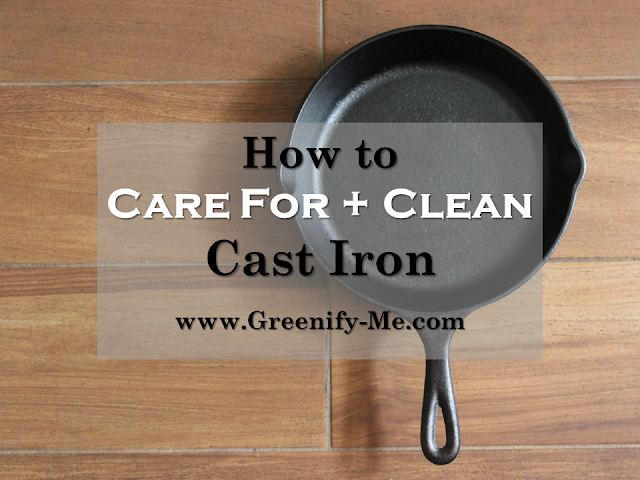Are you curious about how to care for and clean cast iron? Many people are, but believe it’s too much work and upkeep. The honest truth is cast iron skillets require very minimal care, are pretty cheap, and can last a lifetime. All you have to do is know the basics to caring for them and they’ll become your most prized kitchen tools. I would know: My trusty Lodge 8-inch cast iron skillet is pretty much my go-to in the kitchen now. I use it to make everything from omelets to stir fries. It’s super easy to clean, low fuss, and practically unbreakable. What’s not to love?
As a zero waste advocate, I’m in love with items that are built to last (a stark contrast to single-use disposables). Cast iron will last for a lifetime – maybe even longer. I’ve heard of people finding vintage, rust covered cast iron skillets and cleaning them up, making them work like new again. Who’s to say long after I’m gone my beloved cast iron skillet won’t go on to be used by some other eco-conscious person? I have high hopes it will.
The other amazing thing about cast iron is it doesn’t have any Teflon coating on it. Teflon can be found in most nonstick pans nowadays. Teflon, when heated to high temperatures (which happens whenever you cook), releases toxic fumes harmful to humans and lethal to pet birds. Never cook with a Teflon pan around pet birds, that’s for sure: It can outright kill them, and has happened on multiple accounts. Is that something you want to expose yourself, or your family to? No thanks. I’ll stick to my cast iron skillet thank you very much.
If you’re ready to say goodbye to nonstick pans and want to purchase a cast iron skillet, Home Goods is a decent option, along with thrift stores. You can also purchase cast iron online at relatively low prices. Amazon sells my 8-inch Lodge cast iron skillet for about $11 (shipping not included). If you already have a cast iron skillet, but are afraid to use it, get ready. I’m going to show you the basics for caring and cleaning cast iron so you can get cooking ASAP. Also, just a heads up, I do have some affiliate links in this post. It’s to a cast iron skillet I myself use and recommend. Now without further ado, here’s how to care for and clean cast iron!
______________________________
Seasoning cast iron
Here’s how to season cast iron properly:
- Add a little bit of unsaturated oil onto your skillet. Using a reusable cloth (or a paper towel which you can compost directly after use), rub the oil all over (inside and out). Don’t lay the oil on too thick, and make sure to buff it until it looks almost dry.
- Pre-heat your oven to 450 degrees. Pop the pan in for 30 minutes. Repeat this baking cycle at least 3 to 4 times. By then, you should have a nice, well-seasoned pan ready for cooking!
I highly recommend heating your cast iron skillet for a least five to ten minutes (on low) before cooking with it. Don’t even add oil to it while it heats for these first few minutes. This will activate its non-stick properties, making for much easier clean up. I use this technique all the time when cooking eggs and oh my god does it work. Prior to this method, I was scrapping off stuck on egg for at least 10 minutes after cooking! Now, nothing. My pan is ridiculously easy to clean.
Speaking of cleaning…
- After cooking with your skillet, add hot water to a hot pan (I usually move it into the sink, grabbing it with my dish towel – the handle gets really hot!). You can also pour in the hot water using a measuring cup.
- Using your preferred scrubbing device (sponges, wooden pot brushes, wooden dish brush, copper pot scrubber, etc.), scrub the pot lightly. If you’re afraid you’ll burn your hand, wear gloves, or use some tongs to hold your scrubbing device at a safe distance.
- Rinse the pan with hot water. Wipe dry with a towel, or put it on low to medium heat on the stove to evaporate any excess water. Excess water on your cast iron can cause rusting.
- Add some unsaturated oil (flax seed, canola, vegetable, or corn oil work) to your pan and buff it out using a rag (or a paper towel – compost after use). You want to apply a thin layer, not cake it on.





Pan has been use for cooking our daily foods as this pan is really useful for making any kind of food. So it is really necessary to clean this pan and iron kind of things properly.
For cleaning cast iron pans, use squares cut from an old cotton shirt instead of a paper towel (no waste) to wipe away the leftovers. The squares can be soaked overnight in regular laundry soap if necessary, and washed in hot water and reused. For these, stains really don't matter. Also, instead of soap, use a couple tea spoons of kosher salt with a shirt square on the dry pan to "scour" the bits off. This is not too abrasive. Soap will really ruin the seasoning you have worked so hard to create. Non-sticky leftovers, like from re-fried beans or eggs, don't really need "cleaning", just wiping.
The copper on the outside will still provide the superior heat conductivity that you want even when they're lined on the inside. Copper Cookware